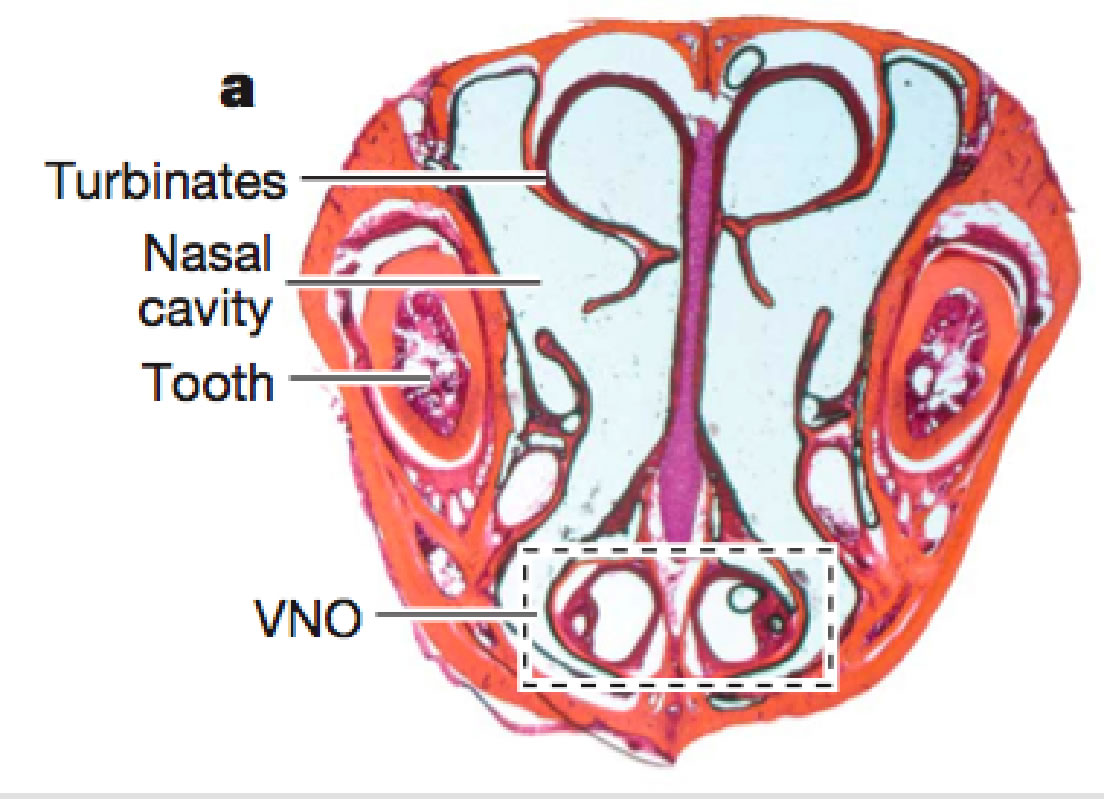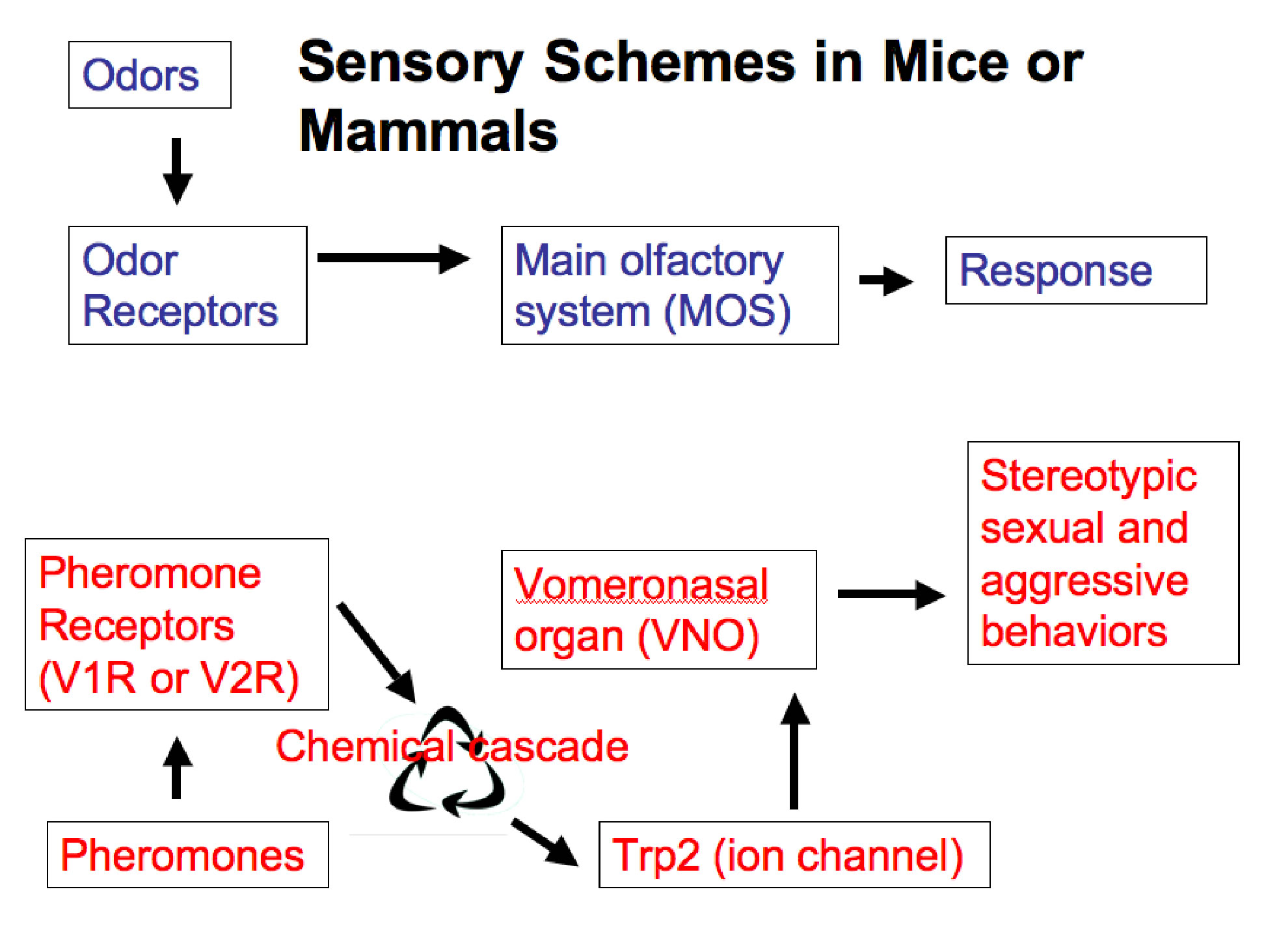 Pheromones in Mice
Pheromones in Mice
Biology 342 Fall 2007
Written by: Emmeline Chuu and My Linh Nguyen

Reed College
3203 SE Woodstock Blvd,
Portland, OR, 97202
nguyenm@reed.edu
chuue@reed.edu
Last Modified November 2007
Mechanism
Recent studies have focused on examining the mechanisms of the vomeronasal system, attempting to identify structures critical to the mechanism of the vomeronasal organ (VNO), as well as a better understanding of what behaviors are affected by the VNO system.

Figure 1. Coronal section of the mouse skull showing parts of brain including the VNO [Kimchi et al., 2007].
VNO detects Pheromones
It is established that the VNO detects pheromones from other animals, and this detection induces stereotypical sexual or aggressive behaviors in individuals. These studies help to clarify the mechanism of these stereotypical behaviors in mice. Past studies have shown the hormonal effects of pheromone detection in the VNO, such as the Lee-Boot effect, wherein female mice show suppressed estrous cycles when females are isolated from males. Other documented effects known are the Bruce effect and the Whitten effect [Halpern, 1987].Current studies have been centralized around the TRPC2, expressing a TRP2 ion channel that is expressed solely in the neurons of the VNO. Because of this genes localization to the VNO, studies with knockout TRP2 gene have allowed researchers to discover more the elements at work in the VNO system.
Mutation of the the TRP2 gene Affects Behaviors in Mice
A recent study, also using mutations of TRP2, found that the disruption of the transduction channel in TRP2 mutants adversely affects the behaviors of mice. Mice with homozygous TRP2 gene mutations displayed decreased electrophysiological response to urine pheromones in the VNO in comparison to wild type mice and heterozygous TRP2 mutants. TRP2 mutant males and TRP2 nursing females fail to exhibit stereotyped behaviors, including aggressive behaviors when intruder males are introduced. TRP2 mutant males were also found to mount other males significantly more than in wild- type mice or heterozygous TRP2 mutants, indicating that the TRP2 ion channels assist in determining gender and individual identity. These results establish that TRP2 is needed within the VNO for a functional VNO. Without proper VNO functioning, the incapability for distinguishing between sexes changes the aggressive behaviors as well as partner selection [Leypold et al., 2002]. It has been accepted that pheromones are essential for partner selection and the triggering of sexual behavior [Andreasen et al., 2002], an idea supported by the previous study as well as in several other studies regarding male mice behavior in the absence of a functional TRP2 gene [Stowers et al., 2002].In another study focusing on the effects of knockout TRP2 genes on female mice, researchers found that TRP2 mutant females exhibited reduced levels of female-specific behaviors, such as lactating behaviors and maternal aggression [Kimchi et al., 2007]. Further, this study found that females lacking a functional TRP2 gene displayed behaviors that were previously thought to be unique to male mice. These behaviors include mounting, pelvic thrust, solicitation, anogenital olfactory investigation, and emission of ultrasonic vocalizations towards males and females. These behavioral phenotypes are the same in female mice with their vomeronasal organs surgically removed [Kimchi et al., 2007].
From these studies, we find that not only is a functional VNO crucial for pheromone- mediated behaviors like sex discrimination or male-male aggression, it is also critical for the repression of male behaviors in females and for the activation of female behaviors. These results also show that the neuronal circuitry for male-specific behaviors is present in the female mouse brain [Kimchi et al., 2007], and challenge the traditional model of sexual dimorphism as a result of sex hormone differences.

Figure 2. Flow diagram of current knowledge about the sensory mechanism in mice. [Source: My Linh Nguyen]
In summary, the overall mechanism of aggressive and reproductive behaviors in mice begins with pheromone detection by the pheromone receptors (V1R or V2R). The receptors stimulate a chemical cascade that affects the TRP2 ion channel found in the VNO, which then induce stereotypic behaviors in mice as illustrated in Figure 2.